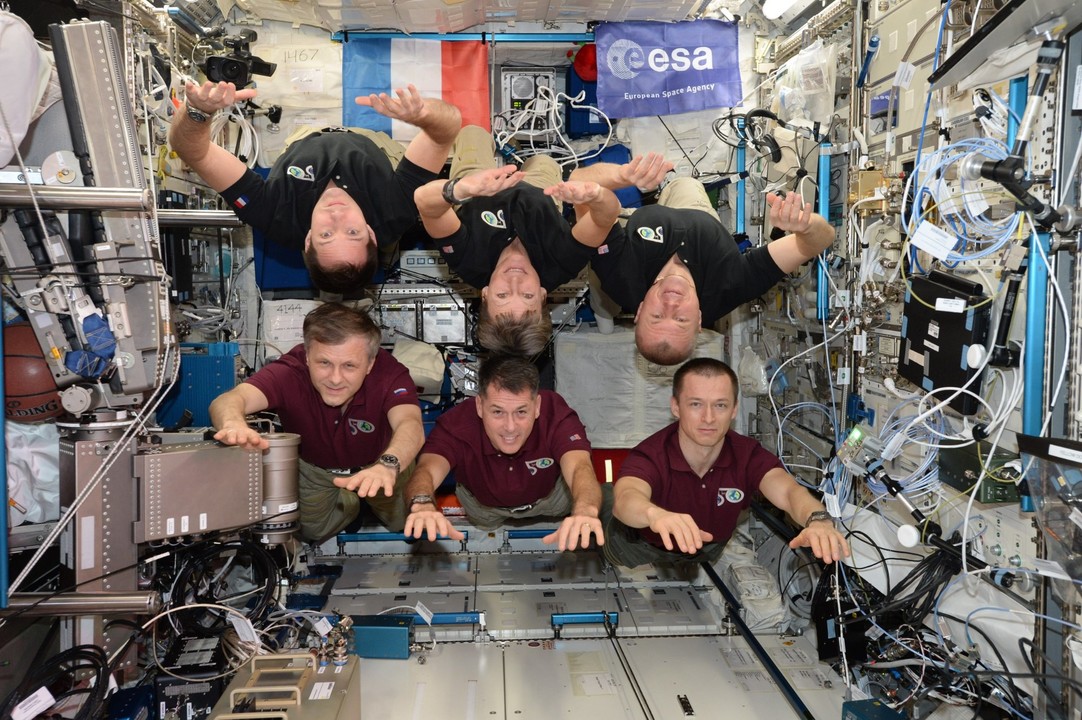
There are many paths to space. The current Space Station crew and their careers
Our Expedition 50 crew photo. You might see six astronauts, or five men and a woman, or three Russians, two Americans and a Frenchman. But what I see is a bio-chemist, a flight controller, four pilots, two engineers, one teacher, three military officers – all working as a team in space… yes that is more than six careers combined! Like for every job, there is no straight path to becoming an astronaut: life is made of experiences and connections, and in space too you have to choose the right ones.
Oleg Novitsky is a real spaceman on his second flight! Oleg is the Soyuz commander for the flight that brought Peggy and I up to the International Space Station. He joined the Russian cosmonaut corps over 10 years ago and was a pilot in the Russian air force before – like many astronauts and cosmonauts. Pilots have proven experience of working and staying calm under pressure with machinery that requires a logical approach with checklists. Here Oleg is wearing Russian 'Chibis' trousers that reduce pressure around the lower limbs, which sucks blood back into the legs and away from the head and upper body, pulling blood to the feet. In space without gravity, astronaut's blood tends to stay around the head. Human hearts are made to counteract the effect of gravity that pulls fluids in our bodies downwards when on Earth – this natural system is not adapted to space so we need to conduct research to find ways to help our bodies out.
Peggy Whitson is one of the most experienced Space Station astronauts ever – she practically built the outpost where we now live! She was part of Expedition 5 in 2002 (we are now part of Expedition 50) and she is set to break the record of the longest cumulative flight time in space for any non-Russian astronaut. Peggy has many spacewalks under her belt using both the American and Russian spacesuits. She installed the backbone of the Space Station as well as adding the Harmony node, the European and Japanese laboratories and the Canadian-built robotic arm called Dextre. Peggy has a background in biochemistry and a PhD from Rice University, Houston, Texas. She was very happy recently to receive a microscope to work on stem-cell research in space. When Shane leaves us to return to Earth, Peggy will take over as commander of the Space Station.
Andrei Borisenko knows everything about space stations as he worked in flight control for the Russian Mir space station and for the International Space Station before becoming a cosmonaut back in 2003. He started his career as an expert in spacecraft flight control and dynamics so that is how he got involved in space. He was also the Space Station commander in 2011! Here Andrei is working with the Russian spacewalk suit called Orlan. Spacesuits often need to be checked and maintained even when not used. Andrei is wearing headphones to listen and talk to ground control in Moscow. You will see he is wearing glasses – contrary to popular belief you do not need perfect vision to become an astronaut, as long as you have good vision when wearing glasses you should be eligible.
Sergei Ryzhikov is one of the three Russian cosmonauts up here and a pilot too — a lieutenant colonel in the Russian air force. He was selected as a cosmonaut in 2006. He arrived two months before me on the Space Station, but it is also his first spaceflight. We have known each other for a few years now: we both took part in ESA's underground training course CAVES 2011. Underground, trainers from the European Astronaut Centre simulate conditions in space, from running scientific experiments to 'cavewalking', exploring and living in a unique and extreme environment. It is good to be back working with him!
Shane Kimbrough is the current International Space Station commander and one of his many tasks was to welcome us and show us the ropes to the Station when we arrived. Shane too is an aviator, from the US army, before he became an astronaut in 2004. He grew up in Texas and aimed to be an astronaut from the beginning, getting a bachelor degree in Aerospace Engineering from the US Military Academy in New York. He has experience with the Space Shuttle and has performed four spacewalks two of which were with me.
🚀🚀🚀 You can follow European Space Agency here





Business Development for Lewis Transcontinental.
3yWww.allegiantga.com
Founder & Sr. Consultant
6yNice article ! Where are you?
Global Lead: R&D Biologicals
7yAnd where is Thomas Pesquet? Wonderful article, I love NASA.
R.N. at Christus Spohn Hospital Memorial
7yCongratulations. You are all very inspiring.
Awesome - your courage is admireable